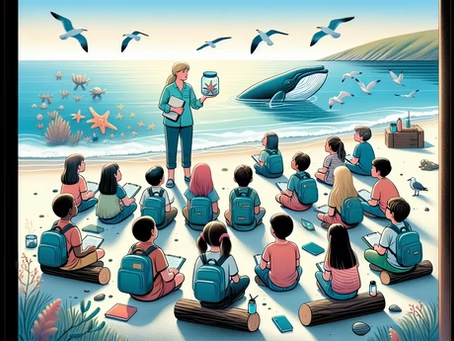Introduction
Marine conservation education is essential for shaping how the next generation perceives and protects our oceans. By combining interactive activities, storytelling, cooking classes, beach cleanups, and digital learning, children develop both knowledge and a sense of responsibility. These experiences create ocean advocates who will carry conservation values into adulthood.
The Importance of Early Education
Instilling respect for the ocean at a young age builds a foundation for lifelong stewardship. Children who are exposed to marine concepts early are more likely to:
- Appreciate the beauty and complexity of marine ecosystems.
- Understand human impacts on ocean health.
- Adopt eco-friendly choices in daily life.
- Advocate for policies that protect marine resources.
Early marine education transforms abstract ideas into meaningful lessons, ensuring future generations value conservation as a way of life.
Interactive and Hands-On Activities
Engaging Children in Conservation
Practical activities foster a direct connection to the sea. Examples include:
- Beach treasure hunts that highlight marine biodiversity.
- Mini aquariums to explore aquatic habitats.
- Crafting projects with recycled materials to address pollution.
Such experiences create lasting memories while strengthening children’s passion for protecting the marine environment.
Real-Life Impact Through Youth Involvement
Children actively contribute to conservation through citizen science projects, biodiversity tracking, and creative platforms like digital games. These opportunities show them that their actions matter and can inspire meaningful environmental change.
Storytelling and Marine-Themed Literature
Inspiring Through Narratives
Storytelling helps children emotionally connect with ocean life. Tales of sea creatures, challenges, and environmental heroes encourage empathy and action. Post-storytime discussions such as “What can we do to protect the ocean?” turn stories into actionable lessons.
Books and Creative Expression
Illustrated marine-themed books make conservation relatable. Teachers and parents can extend the experience by:
- Discussing story morals and real-world connections.
- Encouraging kids to write or draw their own ocean stories.
- Linking tales to conservation activities such as recycling or cleanups.
Aquariums as Conservation Classrooms
Aquariums provide an immersive way to learn about marine life. Conservation-focused exhibits and tours demonstrate:
- The diversity of ecosystems and species.
- The effects of human activity on oceans.
- Solutions for protecting marine habitats.
Families often leave inspired to adopt sustainable practices at home, such as reducing plastic use and making ocean-friendly food choices.
Creative Approaches to Marine Education
Blending Art, Culture, and Conservation
Art offers a unique avenue for marine education. Activities include painting, sculpture, and plays about ocean protection. Student art projects displayed in schools or communities spread conservation messages and foster pride in young creators.
Workshops and Events
Hands-on experiences, from transforming beach debris into art to virtual reality ocean explorations, merge creativity with environmental awareness. These activities help children view conservation as both fun and meaningful.
Cooking, Sustainability, and Marine Life
Teaching children about sustainable seafood links culinary skills to environmental responsibility. Cooking classes can cover:
- How fishing methods affect ecosystems.
- Identifying sustainable seafood choices at markets.
- Preparing simple eco-friendly family recipes.
This approach empowers families to make conscious food decisions that benefit marine ecosystems.
Beach Cleanups and Pollution Awareness
Beach cleanups combine conservation with family bonding. Beyond removing waste, they spark conversations about recycling and responsible consumption. Benefits include:
- Protecting marine species from entanglement and ingestion.
- Improving water quality for recreation and fisheries.
- Raising community awareness about pollution.
Virtual Marine Exploration
Technology brings the ocean into homes through VR tours, educational games, and online platforms. Kids can experience underwater ecosystems, simulate conservation projects, and connect with marine scientists worldwide. These digital tools expand access to conservation education, especially where field trips are not possible.
Integrating Marine Topics in Schools
Schools are powerful allies in conservation. Partnerships with educators can lead to lesson plans, guest lectures, and student-led initiatives such as data collection and awareness campaigns. Field trips to aquariums and coastal areas reinforce classroom learning and create hands-on experiences.
Eco-Friendly Ocean Explorations
Family trips to the coast can double as conservation lessons. Activities like snorkeling, guided tide pool walks, and sailing with eco-conscious operators inspire children while teaching them about fragile ecosystems and the need for protection.
Conclusion
Marine conservation education is about more than knowledge—it is about fostering emotional connections with the sea. From storytelling and cooking classes to virtual exploration and beach cleanups, every experience equips children with the tools to be active ocean stewards. By involving families, schools, and communities, we can inspire a generation that values, protects, and restores our oceans for the future.

